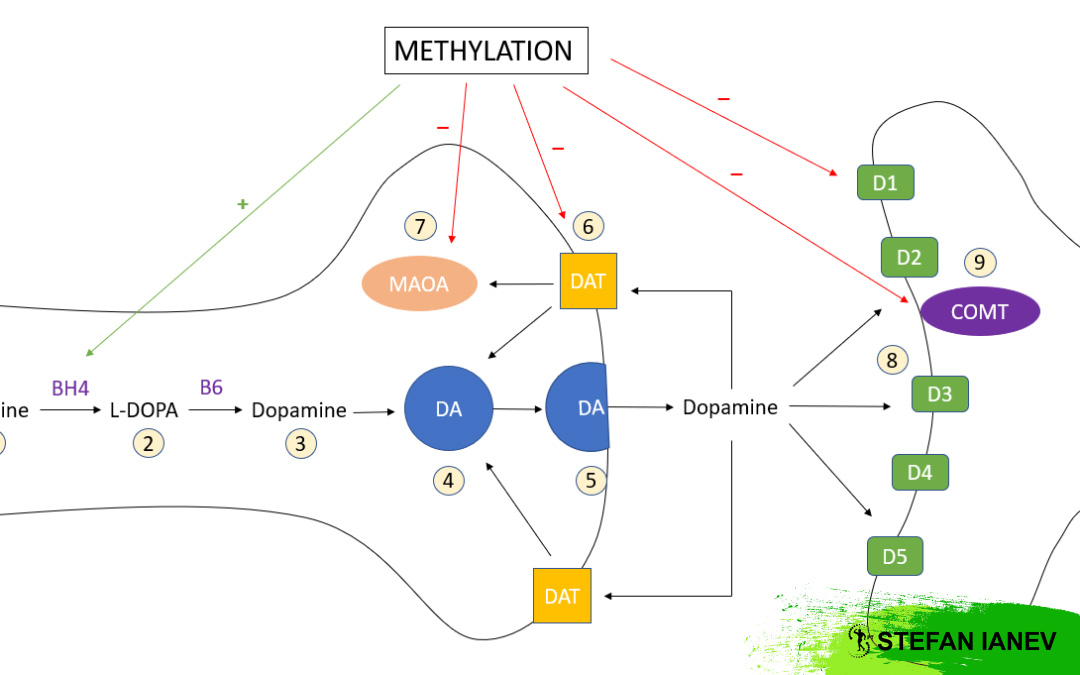Neurotransmitters are brain chemicals that regulate our mood, alertness, motivation, concentration, memory, and personality.
By optimizing neurotransmitter levels in the brain we can achieve peak performance by being more focused and alert, experience more joy and happiness in life, and wind down when we need to so that we can rest and rejuvenate.
Having the wrong amounts of neurotransmitters, either too much or too little, at the wrong times, can either make us feel anxious, wired, irritable, and angry, or depressed, tired, unmotivated, and unable to focus.
We want just the right amount of neurotransmitter activity at the right times, not too little, and not too much. We call this the Goldilocks Zone. The problem is that neurotransmission is a complicated process because neurotransmitter activity in the brain is regulated by many factors.
Let’s take a look at the Dopamine pathway as an example, which is one of our primary excitatory neurotransmitters involved in motivation, pleasure, and reward seeking.

Figure 1 Steps involved in the synthesis and breakdown of dopamine.
- To make dopamine first we need the raw material which is the amino acids phenylalanine and tyrosine (tyrosine can be synthesised from phenylalanine).
- Tyrosine is then converter to L-Dopa through the enzyme tyrosine hydroxylase, which uses BH4 as a co-factor.
- L-DOPA is converted to Dopamine by the enzyme DOPA Decarboxylase, which uses vitamin B6 as a co-factor.
- Dopamine is then actively transported into storage vesicles, ready to be released into the synaptic space (the space between two neurons) by exocytosis.
- When the neuron is stimulated Dopamine is released into the synaptic space by exocytosis.
- Some of the dopamine that’s released into the synaptic space is sucked back into the pre-synaptic neuron by dopamine transporters (DAT).
- Some of the dopamine that’s sucked back into the pre-synaptic neuron is transported back into the storage vesicles for reuse, and the rest is degraded by the enzyme Monoamine oxidase (MAO).
- The remaining dopamine in the synaptic space binds to dopamine receptors on the post-synaptic neuron.
- The dopamine bound to the receptors on the post-synaptic neuron is degraded by the enzyme Catechol-O-methyltransferase enzyme (COMT).
As you can see neurotransmitter activity isn’t just dependent on the amount of neurotransmitter released into the synapse, but also the receptor sensitivity, and the re-uptake and breakdown of that neurotransmitter.
In fact, re-uptake and breakdown usually dominate neurotransmitter activity because that affects how long neurotransmitter levels remain elevated. That’s why pharmaceutical drugs aimed at treating depression and ADD/ADHD such as MAO inhibitors, SSRIs and NDRIs target primarily those pathways.
That’s not to say the amount of neurotransmitter released into the synapse is not important. We still need the raw materials and co-factors from out diet to make our neurotransmitters, but that’s not the dominant factor.
What primarily determines if we have low or excess neurotransmitter activity is the genetic expression of transporter proteins and/or speed of our degradation enzymes, because that determines how quickly the neurotransmitters are cleared and broken down.
For example the MAO-A enzyme which is found in the pre-synaptic neuron is involved in the degradation or serotonin, dopamine, noradrenaline, and adrenaline. The COMT enzyme which is found on the post-synaptic neuron is involved in the breakdown dopamine, noradrenaline, and adrenaline.
Both the MAO-A and COMT enzymes can be either fast or slowed down depending on your genetic SNPs (Single Nucleotide Polymorphisms). That means genetically each person will differ in how quickly they clear these chemicals from their brain.
That’s a big reason why we all have different personality traits. Some people who are slower in clearing the catecholamines i.e. dopamine, noradrenaline, and adrenaline will naturally be more driven, motivated and alert. We call these individuals high catecholamine phenotypes.
But they will also be more prone to worrying, anxiety, insomnia, and burn out. Burn out is largely related to the receptors downregulating because they have been overstimulated. Sometimes it can also be due to depletion of a neurotransmitter or its cofactors but that is less common.
On the other hand we have those individuals that clear their catecholamines very quickly. We call these the low catecholamine phenotypes. These people are naturally more laid back and chilled, but they are also more prone to depression, apathy, binge eating and addictions.
Both phenotypes have their advantages and disadvantages. The reason we call them phenotypes and not genotypes is because these traits are also heavily influenced by the environment. For example mindset, nutrition, training, and lifestyle all play all major role here.
In part 2 of this article we are going to look at how key nutrients influence these pathways so that we can keep our neurotransmitter levels within the sweet spot.







